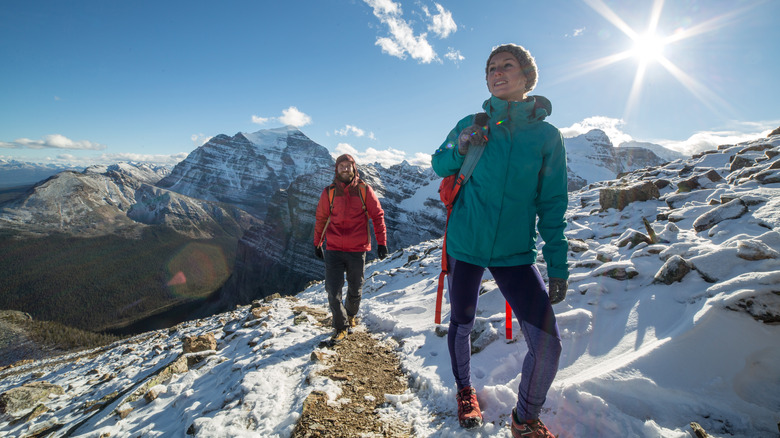National Parks allow visitors to explore beautiful outdoor spaces and connect with nature. Many of these marvelous celebrations of nature are also free, 365 days a year. Nature is great, whatever the weather, but there is something magical about visiting national parks in winter. With endless activities, including snowshoeing, snowmobile tours, and just about every type of winter sport imaginable, parkgoers should not be deterred by lower temperatures or wintery weather. Of course, nature lovers still need to be mindful of these weather conditions when enjoying all the possible winter fun that awaits. But there is no reason to stay indoors if you do not wish to, even if winter recreation is not necessarily your thing.
That said, there are some important seasonal tips to remember when out adventuring or simply basking in your surroundings while visiting these grand places. This is especially true if you plan to explore these wonderlands on foot via a hike — highly recommended, as hiking is one of the best ways to embrace the great outdoors without overdoing it when it comes to physical activity. So, to help, here are a few things everyone should know before embarking on a winter hike or leisurely walkabout in any of the many glorious national parks in the U.S.
Choosing a park that works for you
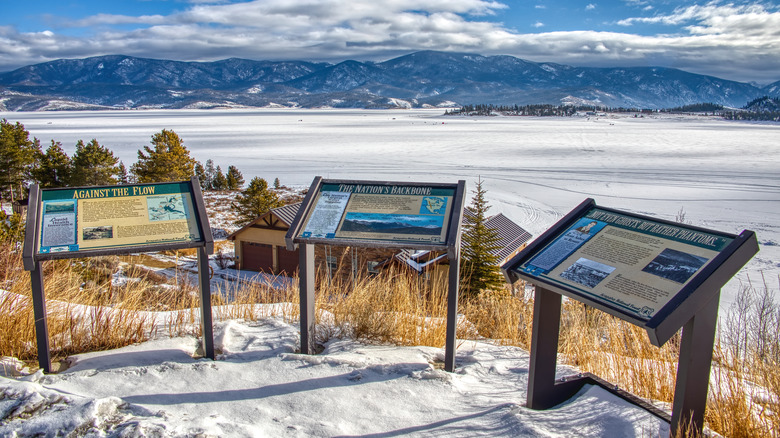
With over 400 national park sites and 63 fully designated national parks in the U.S., choosing the right one for your winter hike will take some research. If you are looking for premium hiking spots that offer an authentic winter experience, you can easily narrow that number to around 20 or so. For instance, beautiful and iconic national parks like Yellowstone, the Grand Canyon, and Colorado’s Rocky Mountain National Park are great options for winter exploration.
An excellent place to start your search is the NPS’s Find a Park website. Once you have selected your desired state and activity — for example, hiking in Utah or astronomy in California — you can begin to hone in on the park for you. One’s hiking experience level should also be considered when planning your winter excursion. For example, winter hiking on the East Coast is definitely not for newbie hikers. Opting for a national park that is open and has clear hiking trails should not be overlooked either. After choosing where you want to go, other musts to stay on top of include the overall trail conditions in winter, what the weather will be like on the day of your excursion, and even the amount of winter foot traffic a particular park gets are all a part of pre-hiking preparedness.
Important safety tips
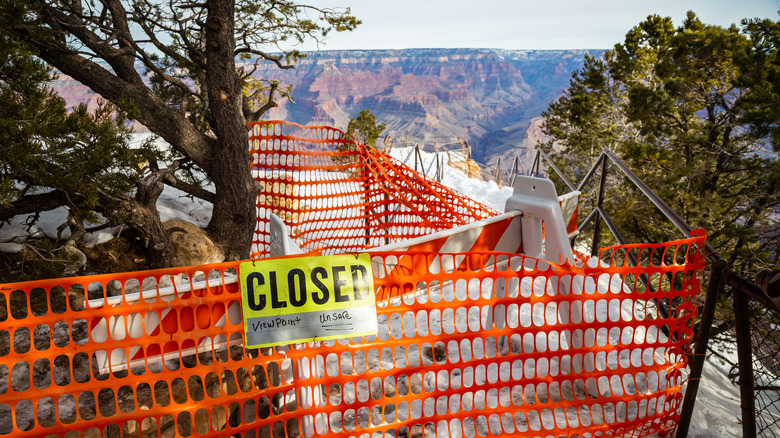
Winter hikers headed to national parks should always exercise caution and be aware of all safety measures that commonly come in handy during weather changes. No matter how much planning and researching you do before setting out on your national park adventure, there is no denying the fact that the weather can change on a dime. But that does not mean you should simply take your chances. It is still beneficial to have an idea of what the conditions are like during this time of year so you are not taken by surprise.
As well as researching weather conditions, all parkgoers should remember to go over the park’s rules and regulations and follow said rules when exploring. Specifically, in the wintertime, it is also crucial that hikers stay off the ice, keep to the trail, stay hydrated, bring snacks, and avoid putting themselves at risk of injury just for the sake of a photo — this also includes staying clear of any wildlife while visiting. Remember, hiking is supposed to be exhilarating but not at the expense of your or your hiking partner’s safety.
Potential hazards
Outdoor activities come with their share of potential hazards. Everything from hypothermia to avalanches can happen on your winter trek, so it is vital to prepare for it all. Typically, hikers need to be mindful of frostbite, hypothermia, getting lost, unexpected weather changes, and getting trapped in an avalanche. Nonetheless, most of these things are avoidable if you plan accordingly.
One of the easiest ways to combat the cold during your winter trek in a national park is to dress warm, stay dry, and stay low — your elevation level plays a role in what the wind chill feels like. It also helps to utilize the daylight and better weather, as temperatures start to dip when it gets dark. What’s more, by making the most of how much sunlight you have left, sticking to the trail, following the map, and bringing along your GPS device, you can avoid getting lost while hiking in nature. When it comes to sudden changes in weather, including avalanches, the best thing to be is prepared. Having a plan of action for avalanches can mean the difference between life and death — move out of its path, stick to the trees, and stay as calm as possible. Easier said than done, of course, but it all helps. Wearing moisture-wicking materials, donning warm, waterproof outerwear, and having the right gear in tow, such as an emergency shelter (blanket or bivy sack) and headlamp, can help you steer clear of dangers.
Winter hiking prep
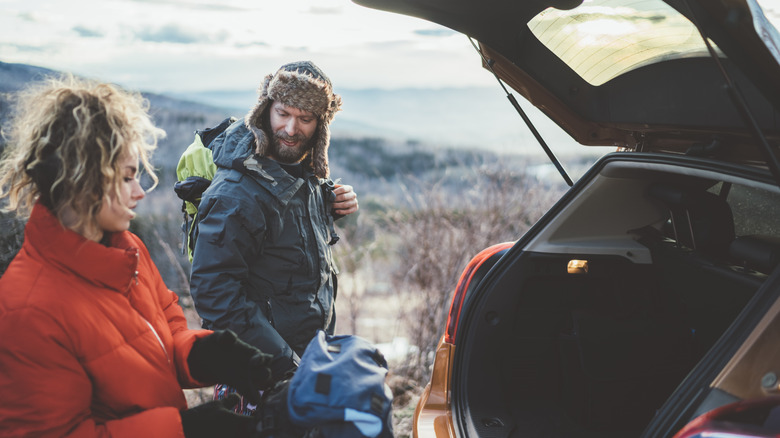
Martin-dm/Getty Images
Doing the necessary research is always the first step to any successful hike, no matter the weather. But in a national park in the winter, you will need to take things a few steps further. For instance, you need to assess how far you have hiked recently without snow and ice. Think about your cut-off — maybe it was 4 miles or more before you started to wish your warm weather trek was over. Whatever the distance, it is best to divide that number in half. So, if you had no problem completing a 6-mile trail in amenable and snowless weather, then you should expect to be able to cover roughly 3 miles in winter.
After figuring this out, start looking at the park’s trails to see which one(s) fit the bill. It is highly recommended that you focus on open popular footpaths, as they will likely be better maintained, and others will have paved the way for you in the snow. That said, if you prefer more of a challenge, you can consider trails with some elevation or a slight incline for a sweaty workout with a view, although make sure you do not go too high. Once you have a few good routes in mind, then you can move on to packing for the cold weather ahead.
Essential gear
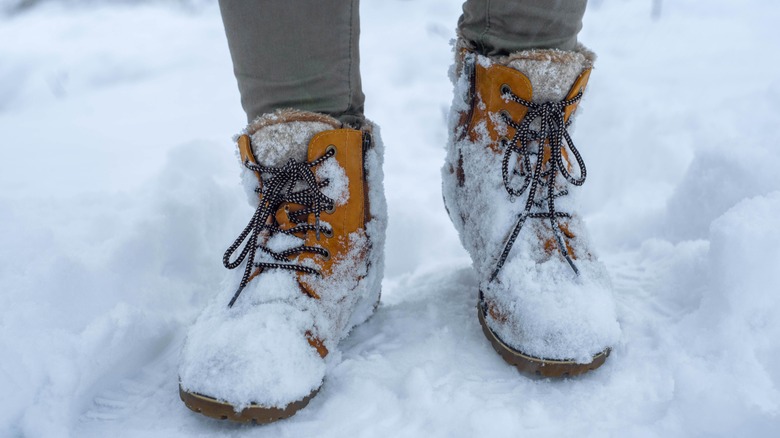
Artistgndphotography/Getty Images
The gear you decide to bring can make or break your winter hike in a national park, so it is vital to have the essentials. Of course, hikers need the appropriate footwear when out and about. Good quality hiking boots that are well-insulated, waterproof, and can protect your feet in sub-zero temperatures are a winter wonderland requirement. For backcountry traipsing, snowshoes are always a good option, and for icier conditions, a durable set of crampons or microspikes that work with your shoes should also be considered.
Multiple pairs of wool hiking socks for warmth and gaiters for an extra waterproof layer may come in handy when hiking in snow-covered places. Other must-have items to have on hand for your winter walkabout include an avalanche beacon, a compressive first aid kit, an ice axe, tinted goggles, trekking poles, a whistle, and an all-purpose knife or tool. All these essentials can be stored in a medium to large backpack that is waterproof or has an external cover to protect your stuff from the elements. And while you are at it, some 20+ SPF sunscreen, a lighter, and lip balm are a few more things you can toss in your bag for good measure.
Must-have apparel
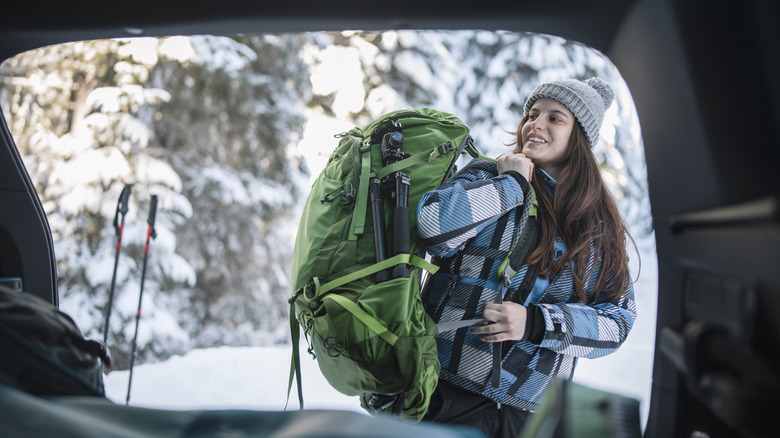
Alena Sharuk/Shutterstock
In terms of must-have apparel for winter trekking in any national park, layers are still the way to go. Typically, when spending long periods of time outdoors in colder weather, a three-part layering system — base (upper and lower body), mid, and outer layer— is recommended. The must-have apparel for your national park excursion should be the same.
Winter hikers should opt for a base layer made of fleece material or Merino wool and not cotton-based to stay as warm and dry as possible. Everything from socks up should work together to wick away moisture and keep you nice and cozy. A mid-layer that insulates can easily be your favorite lightweight hoodie or pullover as long as it is not too bulky. For an outer or shell layer, it is best to wear a jacket that protects from all wintery elements (wind, water, and varying degrees of cold). Doing so will allow you to regulate your exposure to the cold by being able to adjust as needed. And remember, your winter hike apparel should include more than one pair of gloves, an insulated hat (with a hooded jacket), a face mask, gaiters, sunglasses, and any other necessary outdoor winter accessories (hand warmers, foam pads, and so on).
Stoking your internal furnace
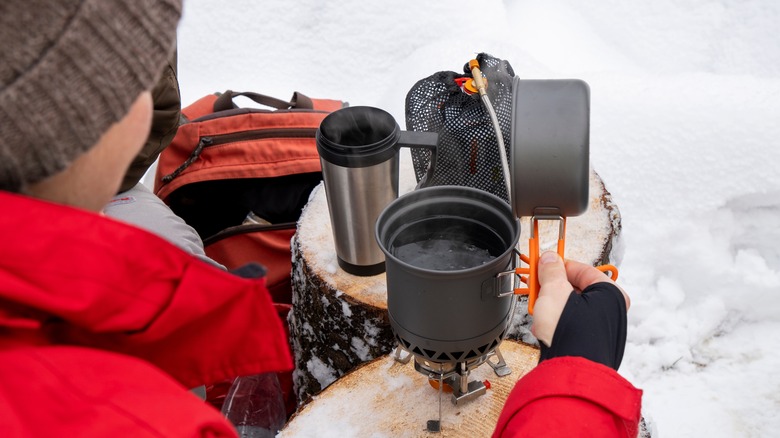
dr.D/Shutterstock
There are several other ways you can stay warm during your winter hike — mainly by stoking your internal furnace. Winter explorers need to preserve their body heat, especially when spending hours in the cold. One way to do so is by keeping it moving. Yes, you are here to enjoy the view, but you should not spend hours lounging about or sitting on wet surfaces (here is where your foam pad comes in handy). Another pro tip to avoid feeling the chill is to protect your hands and feet at all costs — as it is much more challenging to warm up again when outdoors.
It is also vital that you bring ample food with you, not only in case of emergencies but also because you are burning off energy with every step you take, particularly in the dense snow. Thus, protein bars or snacks that are quick and easy to digest yet still pack a punch (or that are calorie-rich) are good selections here. Likewise, in order to stay hydrated, you will need to bring water with you. But that does not mean it needs to be icy cold; warm drinks like tea, hot chocolate, or even room-temperature water are best when attempting to maintain your overall body heat.
Hike with others
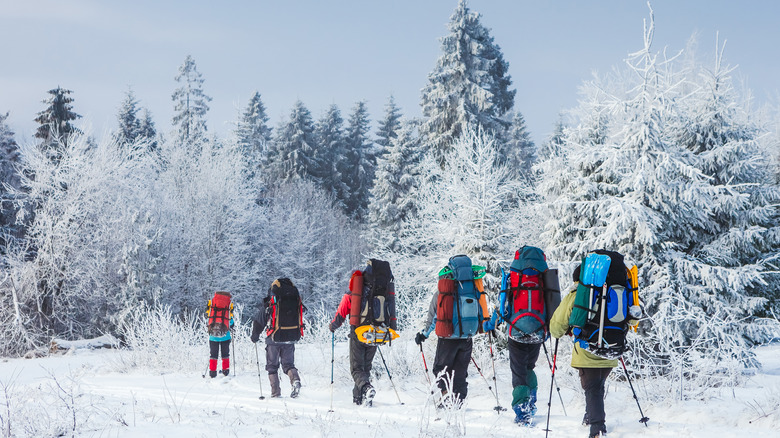
Olga Danylenko/Shutterstock
Undoubtedly, winter hiking has more than a few benefits. For example, if you feel the effects of Seasonal affective disorder (SAD) or are just looking for a way to improve your mental health, a walkabout in nature can be an excellent remedy. Winter hikes also provide an opportunity to work on your physical fitness. Therefore, it can be tempting to trek it alone because you are focused on your self-care or craving some quiet time. This isn’t the best idea — it is actually better to hike with others for a variety of reasons.
Not only is it safer to hike with others as potential hazards increase in wintertime thanks to the weather, but it is also a lovely way to have a shared experience with someone. Moreover, a hiking buddy can help carry the load — making your overall hike more enjoyable because you are literally not being weighed down by all your gear in the snow. Plus, if you have to travel quite a distance to get to your dream park, someone is there to help share costs and photograph your epic adventure, and you are less likely to get lost if you roam about a national park with someone else. So do not forget to implement the buddy system (make sure you tell others of your plans as well) when hiking, especially in winter.
Be flexible when setting expectations
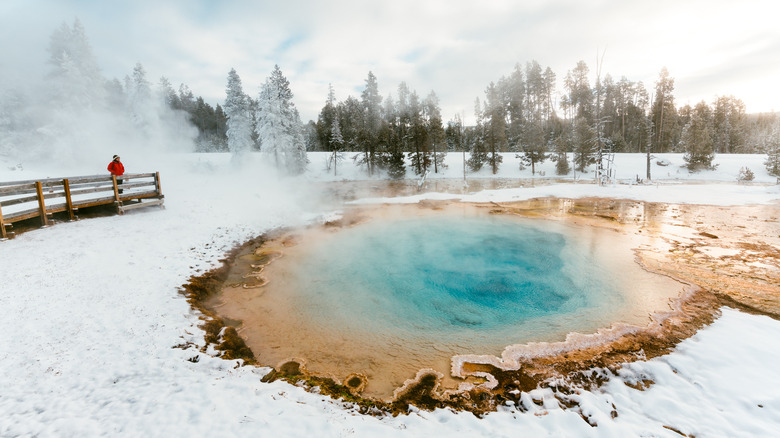
Ferrantraite/Getty Images
Your winter hike is meant to be a pleasurable experience with others, so remember to be realistic about your goals and remain flexible when setting your expectations. This means constantly reevaluating what you can accomplish in not-so-pleasant weather or adverse conditions. When in doubt, pushing on is not always a good move. It is undeniable that trekking through the snow in a national park requires a lot more effort than a summer or fall excursion. Therefore, if you need to turn back or take the shorter trail, then it is perfectly acceptable to do so.
Remember, no one says you have to do it all in one day or a single outing, especially in a national park with lodgings. And with fleeting daylight, renting a cabin and making it a multi-day experience is often better than exploring in the dark. Even if you forgot a vital piece of hiking equipment or gear, such as your snowshoes or gaiters, there are other trails you can choose from that will make your trek safer and just as pleasant. It is a cliche, but it really is better to be safe than sorry.
Have a backup plan
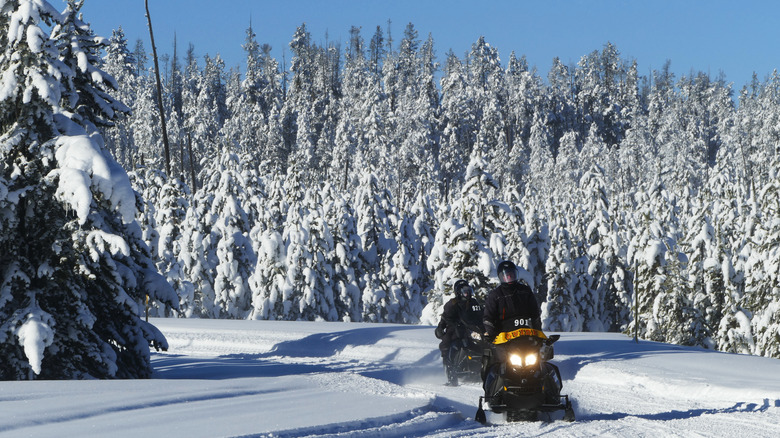
Milan Sommer/Shutterstock
By now, you know that even the best-laid plans are not set in stone, no matter what they are for, and hiking plans are no different. Even when foreseeable issues arise, you might have to switch things up at the last minute, which is not necessarily a negative. If you have a fabulous backup plan, you should have no problem adjusting your national park itinerary. This doesn’t have to be something completely different, of course. It can be as simple as researching other trails and footpaths at the park, so if your chosen trail is closed for some reason, you are not left scrambling for an alternative route.
If your winter walkabout is an outright no-go as soon as you get to the park or on the morning of, finding some winter fun that is more your speed should not be too difficult. Everything from snowmobiling and kicking back in the lodge to heading to your second choice pathway are delightful substitutes. In contrast, a minor hiccup like lost gloves or dead batteries in the GPS isn’t such a problem if you or your hiking buddy likely took the time to anticipate it. You might even have the solution to hand. The reality is there are a handful of things that could put a fork in your hiking adventure, so having a well-thought-out backup plan ensures you can still enjoy the great outdoors.
Winter weather makes hiking more difficult but not less enjoyable
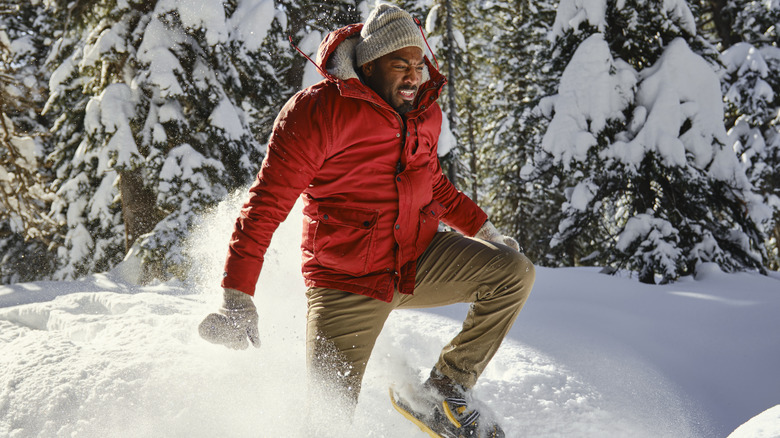
Richlegg/Getty Images
Ultimately, there is no getting around the fact that winter conditions impact one’s hiking experience. Upon entering any park, you will quickly find that no two trails are alike, and there are countless combinations of wintery weather that can directly impact your adventure. So you have to be ready to deal with it all, from cold hiking with no snow or ice to partial snow and ice or abundant and endless snow. Yet, winter hiking is the perfect time to slow down and look at cold weather from a more positive perspective.
Of course, hiking paths you have trekked a thousand times before suddenly become unchartered territory, but walking in a winter wonderland has untold benefits. All you have to do is research, plan, and prepare for a memorable outing that is also quite empowering. Plus, with fewer crowds, you can get a better sense of the park and a better view of it all. And if you happen to love the sheer beauty of nature in the wintertime, then there are a multitude of snow-covered national parks with your name on them.

